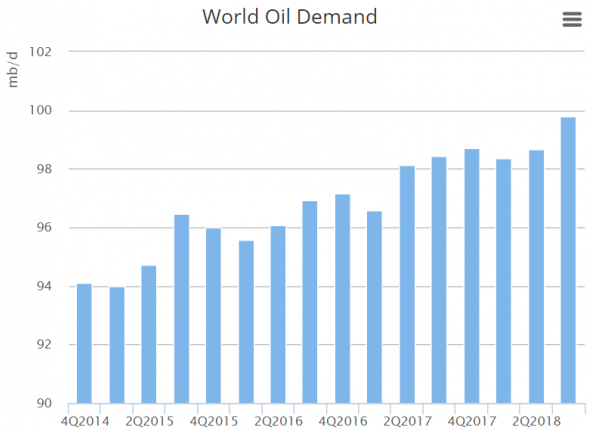The International Energy Agency’s (IEA) five-year outlook expects that the United States will overtake Russia and potentially Saudi Arabia as an oil exporter by 2024. The U.S. shale revolution—thanks to hydraulic fracturing and directional drilling—has made the United States one of the world’s largest energy producers and potentially the largest oil exporter globally within five years. Forecasters expect the United States to become a net energy exporter by 2021, with its liquids production increasing by a record 2.2 million barrels per day in 2018. This one-year increase is slightly less than the total annual production of Kuwait and slightly more than the production of Nigeria, the 6th and 7th producers in the world, respectively. IEA expects the United States to provide 70 percent of the increase in global liquids production capacity by 2024—4 million barrels per day. Shale oil and liquefied natural gas (LNG) are increasingly in demand with Asian countries, particularly China.
Total non-OPEC production is expected to increase by 6.1 million barrels per day through 2024 due to a combined additional increase in production capacity of 2.6 million barrels per day from Brazil, Canada, Norway, and Guyana. The OPEC countries of Iraq and the United Arab Emirates are expected to add production capacity but those gains are offset by losses from Iran and Venezuela resulting in a net loss in OPEC production capacity of 0.4 million barrels per day.
U.S. Oil Production and Export Expectations
IEA predicts that U.S. oil and natural gas liquids production will increase to 19.6 million barrels per day from 15.5 million in 2018, due largely to the prolific Permian Basin. Permian production is up 1 million barrels per day from last year and is expected to increase an additional 1 million barrels per day by 2020, especially as new pipelines are brought online.
The United States is expected to double its gross crude oil exports to 4.2 million barrels a day by 2024, while total exports of crude and refined products should reach almost 9 million barrels a day, pushing the United States past Russia and coming close to Saudi Arabian export levels.
Liquids Demand
While growth in global oil demand is expected to lessen, IEA does not expect liquids demand to peak. IEA expects global oil demand to grow at an average annual rate of 1.2 million barrels a day, reaching 106.4 million barrels a day in 2024, compared with 99.2 million barrels a day in 2018.

Developing economies are expected to account for the majority of the increase in the demand for liquids. China and India are expected to account for 44 percent of the 7.1 million barrel per day growth in global liquids demand through 2024. IEA expects India’s oil demand growth will match that of China by 2024.
IEA expects the increased demand for liquids to come from increased demand for petrochemicals and aviation. The petrochemicals industry is expected to add 2.2 million barrels per day to oil consumption through 2024, accounting for 30 percent of the growth in global demand. Due to rising incomes in developing countries, aviation demand is expected to grow strongly with more airport construction and more airline fleets. Asia is expected to account for 75 percent of the increase in aviation fuel demand through 2024 with China having the largest absolute increase and India having the fastest rate of growth at 8.2 percent per year.
The global rate of growth in gasoline demand is expected to decline to less than 1 percent per year due to ongoing efficiency improvements. But, the rate of growth is twice as high in developing countries as rising income levels lead to more vehicle purchases.
Refinery Changes
The marine regulation requiring lower sulfur emissions results in a change to fuel specifications as well as an increase in the demand for ship scrubbers. The high sulfur fuel being displaced may be consumed in the power sector, most likely in Middle East plants.
The average global product barrel is getting lighter as fuel oil demand falls and petrochemical demand increases, which puts the United States in a good position as a supplier of light crude types. Shale oil also helps to meet the new ship requirements and provides naphtha for the petrochemicals industry.
IEA expects the refining industry to add new capacity additions totaling 9 million barrels per day. The agency expects China to surpass the United States to become the global leader in installed refining capacity. Since IEA expects the new additions in refining capacity to exceed the demand for refined products, plant closures may occur to rebalance the market.
Conclusion
IEA expects the United States to provide the largest increase in oil production capacity over the next 5 years and to surpass Russia in oil exports by 2024. Other countries also help to increase non-OPEC oil capacity while OPEC capacity falls slightly due to production issues in Iran and Venezuela. The agency does not see oil demand peaking during this period. The petrochemical and the aviation industries lead oil demand growth increases. The refinery industry will have to retool due to changes in bunker fuel sulfur emission levels and China is expected to have the largest refinery capacity by 2024, surpassing the United States. The United States is clearly leading the world in advances in drilling technologies and production capabilities. Our energy future is looking better with each passing year.



